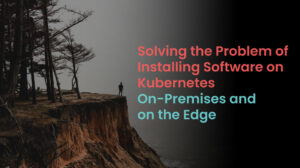BrainBlog for Replicated by Jason Bloomberg
In the first two articles in this series (which you can find here and here), my colleague Jason English explained why many enterprises would prefer air gapped software installs over putting software in the cloud – or anywhere else it might reach the Internet.
This ‘on-premises on steroids’ approach to enterprise software clearly adds security – hackers can’t hack something they can’t reach – and addresses data sovereignty, regulatory control, and even cost issues compared to cloud-based alternatives.
Airgapped software installs don’t come without their own challenges, however – especially for software that is expecting Internet connectivity for updates and patches, access to certificates or key stores, integrations with third-party applications and data sources, or any number of other reasons why software might choke in an air gapped environment.
Replicated has solved this problem by offering enterprises the ability to install even complex, multi-component enterprise applications on air gapped servers by pulling together all the pieces necessary for a turnkey installation that doesn’t require access to the Internet.
However, Replicated’s ability to support air gapped installs is only one specialized use-case of its technology. The vendor has addressed the broader challenge of installing any software in any combination of on-prem or cloud environments – a capability that is especially useful for software vendors who want to deploy their software in pre-configured Kubernetes installs.
Software Installer for Distributed Computing
The easiest way to get your head around what Replicated is doing is to think of a software installer for a PC. The desktop app developer has created all the various necessary components but contracts with a third-party installer vendor to create the installation app for its software.
Replicated does the same thing for distributed applications. It knows where the components go, what third-party elements it must find and install, and how to configure all the various environment bits, from runtime components to digital certificates to metadata.
When a vendor’s software installs directly on bare metal, installation may still be a complex, multistep process. However, it’s now becoming increasingly likely that a vendor’s software runs on Kubernetes.
As a result, installing that software has just become far more complicated. There are different flavors of Kubernetes, including bare metal on-prem alternatives and a variety of Kubernetes-as-a-Service (KaaS) offerings from major cloud vendors, VMware, and Red Hat.
In theory, all deployments of Kubernetes work the same, but in reality, there are numerous minor (and sometimes not so slight) differences that can stop a software install in its tracks. Replicated can resolve these differences, empowering a software vendor to guarantee that its product will install on Kubernetes – regardless of which flavor of Kubernetes its customer operates.



